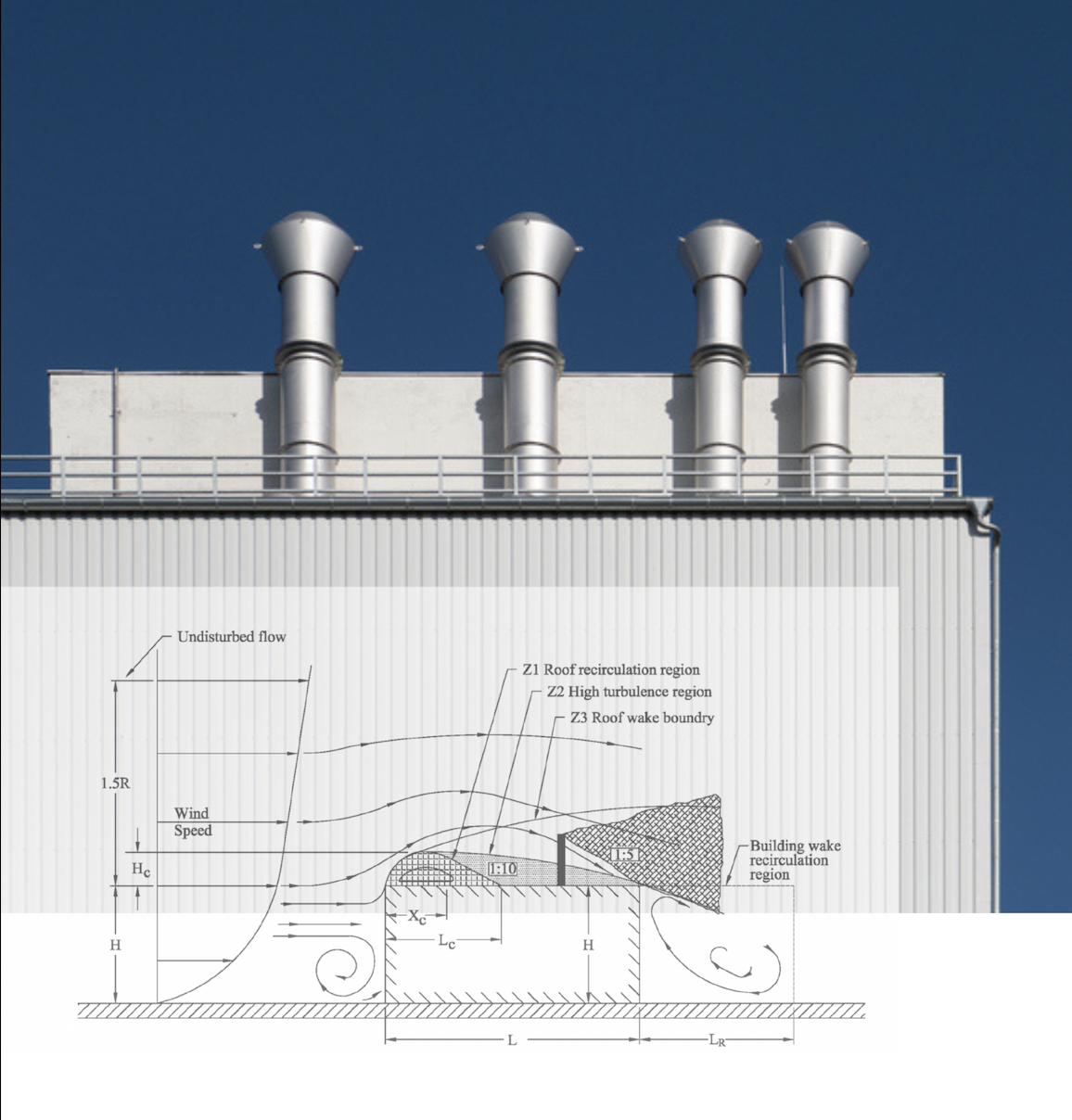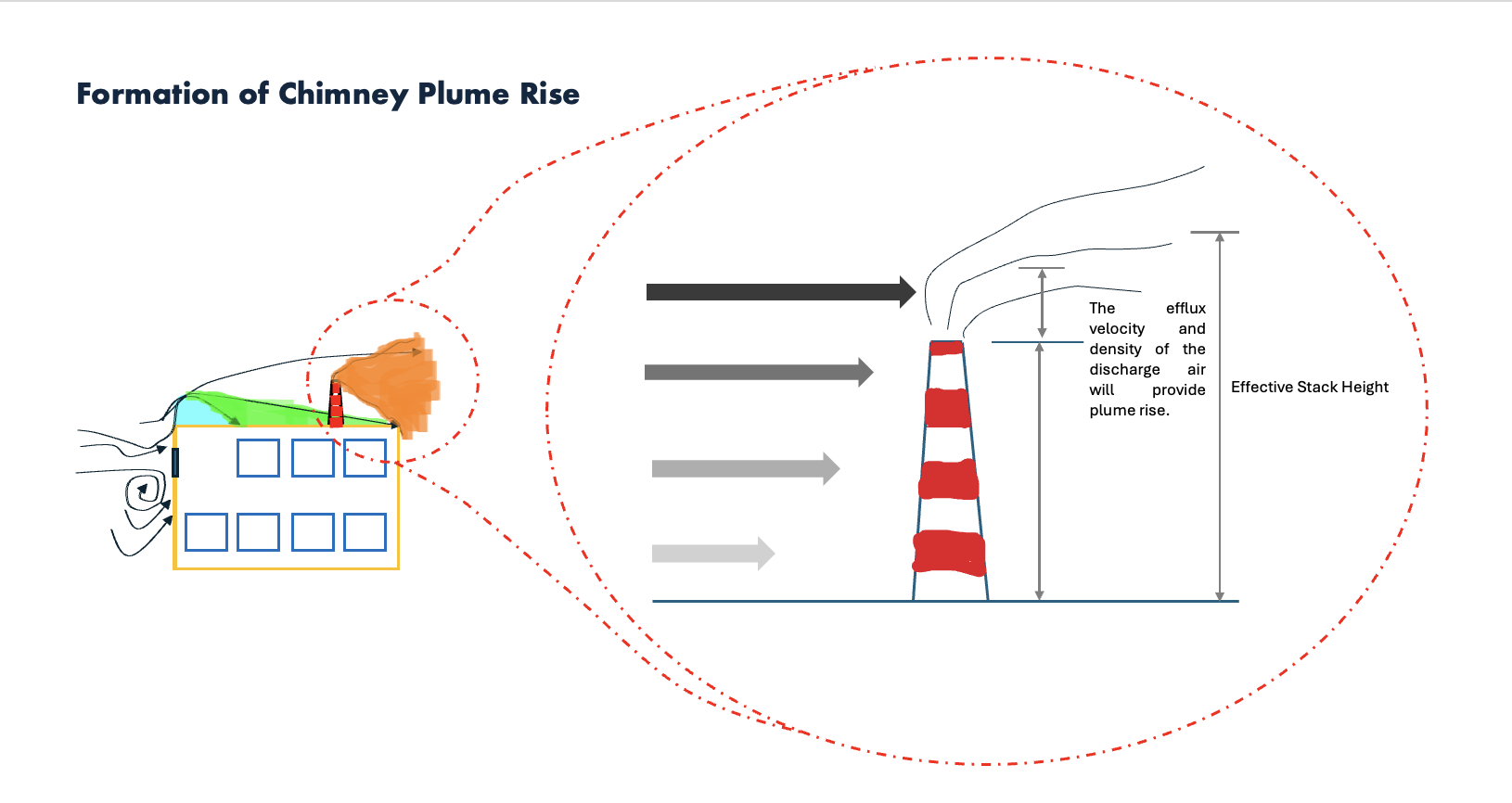Design Specification of a Chimney
Exhaust chimney or stack are the last component of a fuel burning equipment and industrial ventilation system. A fuel burning equipment and industrial ventilation system will be design based on the system flow rate. A fuel burning equipment flow rate will be based on the combustion efficiency meanwhile the industrial ventilation flow rate will be based on capture velocity or air change per hour. A chimney design will be governed by this system flow rate design number. A chimney which is the outlet avenue of the airborne hazard conveying system has the primary function on ensuring the ground level concentration adjacent to this stationary source is not affected by the very same airborne contaminant is it discharging.
The most important design criterion of the chimney is the have emission air borne quality within the threshold limits first. This means usage of chimney as dispersion mechanism has its threshold limit too. If the airborne emission is excessive, abatement process with deployment of effective air cleaning device can be made. The threshold limit values for significant pollution can be found in the Clean Air Regulation 2014 permission threshold limit. However, as the choice of using air cleaning device was not made mandatory, there has been many cases of poorly designed chimney performances which have caused significant environmental impact due to down wash from chimneys increasing ground level concentration of dangerous pollutants. As to put a stop to these dangerous situations, the Department of Environment has made it mandatory for every industrial ventilation system (LEV or GV systems) to have an air cleaning device.
A mandatory installation air cleaning device will ensure the emission from chimney to have a much lower quality of emission. However, a chimney must still be designed using effective design criterion in the event of air cleaning device faulty, permeating heavy load of pollutant. Effective formation of plume rise and dispersion will safeguard the need to maintain good ground level concentration.
When a new chimney is being designed for a ventilation system or a fuel burning equipment, two major criterions to be adhered are :-
The chimney discharge SHOULD escape building envelope so that it shall not return directly into building air intakes.
Upon exiting the building envelope (wake region), the chimney shall generate effective stack height (plume rise), prevents down wash channeling any pollutants towards ground level increasing the ground level pollutant concentration.
Rain Protector
Rain cap, top hat or goose neck elbows can be used on a chimney as it will disrupt the actual function of the chimney to create vertical discharges. Off set chimney or chimneys with jet caps can be used while still maintaining the ability to produce momentous vertical discharges to form effective plume rise.
Factors To Consider For Roof Top Chimney Erection
Air flow pattern resulting from the wind impacting a simple building
Side wall :
The wind which impacts the side wall of the building will generate a downdraft by the deflected airflow. This is why any ventilation system with airborne hazard being conveyed should never be discharged at the side wall without a proper chimney.
Roof top :
A recirculation zone forms at the leading edge of the upwind wall. Cyclonic Vortices will be generated by the wind as air rises and flows over the building’s leading edge. The cyclonic vortices forms recirculation region along the leading edge of the roof and/or roof obstructions. The recirculation energy will be carry forward over the building’s roof and passes over the downwind edge of any roof obstructions and the building’s edge.
USEPA dispersion modelling predicts that the ground level concentration becomes 10 to 100 times more when the emission from the chimney is within these recirculation zones described above. The recirculating zones forms in an area where a relatively fixed amount of air moves in a circular fashion with little air movement through the boundary. It has a swirling pattens which is totally opposite of dispersion. The contaminant will be kept within the vortices. Any chimney emission to this zone will create airborne hazard issue very significant as the emission from chimney is just gonna be dispersed within the building.
Chimneys must be erected in a manner where the emission’s plume will not intersect with the roof recirculation region. Based on description above we can know the air flow patterns towards the building and the roof around a simple building will create significant amount of wake regions. This complexity makes it difficult to simply locate a chimney. The current practise by most of the vendor by sampling adding 3 meter above the roof is not the absolute solution. Making a methodological approach in placing the chimney and increasing the height of the chimney will be a good chimney design basis. A tall chimney has the advantage in overcoming the turbulence flow and have possibility of creating effective stack height. Usage of chimney stack dispersion modelling such as WILSON Modelling or etc will enable a better completion of system design exercise.
Formation of plume rise from a chimney emission
What is Stack Effect ?
Stack effective height refers to the elevation of the vertical discharge of chimney emission. The effective height is the summation of
a. actual chimney height,
b) the plume rise due to the vertical momentum of the emission and
c) any wake downwash effect that may take place.
A wake downwash is generation of downshift air movement due wind velocity being to superior pushing down the emission. A wake reduces the effective stack height. However, if a designer were to make the efflux velocity to be 1.5 times of the wind velocity, the vortex effect can be eliminated.
Generally, when it comes to chimney design exercise, these pointers shall be taken as the basis of the design :-
Effective stack height must be used as basis of design by adding a tall chimney and high efflux velocity (1.5 times more than the wind velocity)
Chimney efflux velocity is a poor substitute for chimney height, which means the chimney has to be placed out side the recirculating zone with good allowance.
Apart from jet cap which still has losses or offset chimney, an efflux velocity above 13 mps can overcome rain entry into chimney as the terminal velocity of rain is just about 10 mps.
Always place a chimney at the highest roof of the building. If this is not feasible, a higher stack with good support will be required. If not the placement of the entire system must be made at somewhere away from the constraints of roof wake.
A cylinder shape chimney is always the best preference due to effective distribution of the air.
Chimney exhaust point must be placed away from HVAC / MVAC air intakes to reduce the effect of re-entry by increasing dilution.
A combined approach of good vertical discharge, chimney height, remote air intakes, high efficient air cleaning device, and internal dilution can be effective in reducing the consequences of re-entry.




